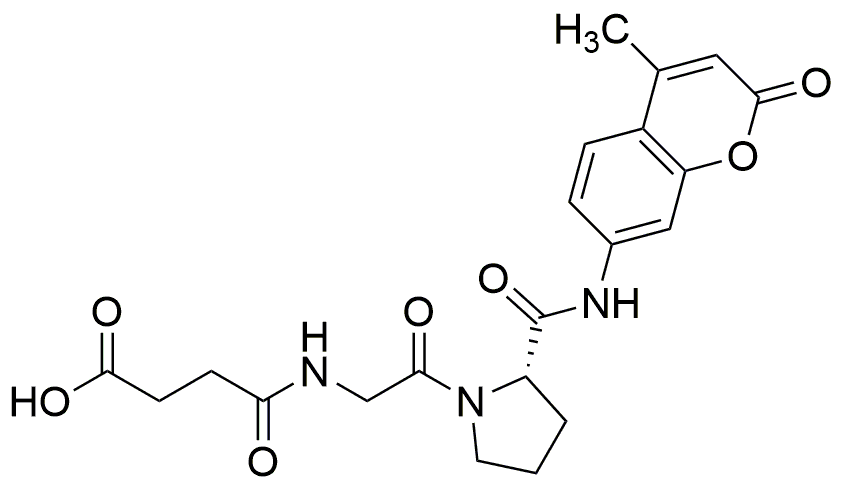Suc-Gly-Pro-AMC is widely utilized in research focused on:
- Protease Activity Measurement: This compound serves as a substrate for various proteases, allowing researchers to measure enzyme activity in biological samples. Its specificity helps in identifying particular protease functions, which is crucial in drug development and disease research.
- Drug Discovery: In pharmaceutical research, Suc-Gly-Pro-AMC is used to screen for inhibitors of proteases that are implicated in diseases such as cancer and viral infections. This application accelerates the identification of potential therapeutic agents.
- Biochemical Assays: It is employed in biochemical assays to study protein interactions and modifications. The compound's fluorescent properties enable real-time monitoring, providing valuable insights into cellular processes.
- Diagnostic Applications: Suc-Gly-Pro-AMC can be used in diagnostic tests for diseases that involve protease activity, offering a reliable method for assessing disease progression and treatment efficacy.
- Research in Neuroscience: This compound is also utilized in neuroscience research to investigate the role of proteases in neurodegenerative diseases, helping to uncover mechanisms that could lead to new therapeutic strategies.
General Information
Properties
Safety and Regulations
Applications
Suc-Gly-Pro-AMC is widely utilized in research focused on:
- Protease Activity Measurement: This compound serves as a substrate for various proteases, allowing researchers to measure enzyme activity in biological samples. Its specificity helps in identifying particular protease functions, which is crucial in drug development and disease research.
- Drug Discovery: In pharmaceutical research, Suc-Gly-Pro-AMC is used to screen for inhibitors of proteases that are implicated in diseases such as cancer and viral infections. This application accelerates the identification of potential therapeutic agents.
- Biochemical Assays: It is employed in biochemical assays to study protein interactions and modifications. The compound's fluorescent properties enable real-time monitoring, providing valuable insights into cellular processes.
- Diagnostic Applications: Suc-Gly-Pro-AMC can be used in diagnostic tests for diseases that involve protease activity, offering a reliable method for assessing disease progression and treatment efficacy.
- Research in Neuroscience: This compound is also utilized in neuroscience research to investigate the role of proteases in neurodegenerative diseases, helping to uncover mechanisms that could lead to new therapeutic strategies.
Documents
Safety Data Sheets (SDS)
The SDS provides comprehensive safety information on handling, storage, and disposal of the product.
Product Specification (PS)
The PS provides a comprehensive breakdown of the product’s properties, including chemical composition, physical state, purity, and storage requirements. It also details acceptable quality ranges and the product's intended applications.
Certificates of Analysis (COA)
Search for Certificates of Analysis (COA) by entering the products Lot Number. Lot and Batch Numbers can be found on a product’s label following the words ‘Lot’ or ‘Batch’.
*Catalog Number
*Lot Number
Certificates Of Origin (COO)
This COO confirms the country where the product was manufactured, and also details the materials and components used in it and whether it is derived from natural, synthetic, or other specific sources. This certificate may be required for customs, trade, and regulatory compliance.
*Catalog Number
*Lot Number
Safety Data Sheets (SDS)
The SDS provides comprehensive safety information on handling, storage, and disposal of the product.
DownloadProduct Specification (PS)
The PS provides a comprehensive breakdown of the product’s properties, including chemical composition, physical state, purity, and storage requirements. It also details acceptable quality ranges and the product's intended applications.
DownloadCertificates of Analysis (COA)
Search for Certificates of Analysis (COA) by entering the products Lot Number. Lot and Batch Numbers can be found on a product’s label following the words ‘Lot’ or ‘Batch’.
*Catalog Number
*Lot Number
Certificates Of Origin (COO)
This COO confirms the country where the product was manufactured, and also details the materials and components used in it and whether it is derived from natural, synthetic, or other specific sources. This certificate may be required for customs, trade, and regulatory compliance.


